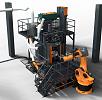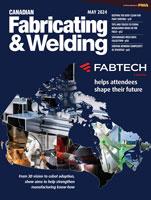- FMA
- The Fabricator
- FABTECH
- Canadian Metalworking
Clamp it down
Proper fixturing is critical for successful welding.
- By Nestor Gula
- April 1, 2015
- Article
- Welding

A solid base and good clamping gear will bring success to any welding operation. PHOTO COURTESY OF STRONG HAND TOOLS
There is no escaping it— solidly clamping parts that you need to weld will ensure that these parts will not move unintentionally and be properly welded. Having pieces of metal move while heat is being applied is a recipe for disaster. Proper hold down of parts to be welded means they can be positioned accurately to make the weld successful.
“A proper fixture should stop and locate stock at accurate angles while allowing adequate space for the welder to operate comfortably and efficiently,“ says Pam Farley, marketing manager for Strong Hand Tools. “A fixture can also elevate stock to create additional welding clearance, and set the structure at a uniform, level height. Fixtures should be designed with possible heat distortion problems in mind and work to minimize those effects. A fixture should be designed, at the outset, with a plan for the removal of the welded piece. Clamps, and clamping elements, should be able to easily swing out of the way for easy welded part removal by sliding off the table or lifting from the top of the work surface.”
Keeping the gap between the pieces to be welded consistent is also critical to completing a successful weld. “Fixturing is used primarily to minimize the gaps to improve the final welding quality,” says Reg Kelley president at Easom Automation Systems Inc. Controlling or minimizing gaps ensures the welding process is not being asked to fill large voids or gaps, notes Kelley.
[gallery type="slideshow" link="none" size="large" ids="109618,109617"]
Modular or customized
When choosing an approach to fixturing there are basically two streams one can choose, modular or customized. In a nutshell, modular lets you adapt standard fixturing tools to suit any situation. Customized is a set fixturing solution that will be excellent for one part and that part only.
“The positive attributes modular fixturing brings to any welding operation is adaptability and repeatability. Adaptability enables a shop to take on a wide variety of jobs without having to create a specialized jig every time,” says Farley. “This is especially useful for short production runs or prototyping jobs where a dedicated jig and fixture will be quickly rendered obsolete by a design change. Repeatability refers to the basic requirements of any jig and fixture to hold work in a consistent and repeatable manner piece after piece. A modular fixturing system allows the welder to react quickly for customer retention, and modular fixturing provides the means to continue generating revenue from the one investment in the fixturing system. Also, the universal system can be torn down and stored away when not in use, freeing up valuable work space in the shop.”
When making many thousands of the same part, or if it’s a very complex part, sometimes a customized fixturing solution will make the most sense. “Custom fixturing works best to fit any unusual structural shapes,” says Kelley, noting that custom solutions are often used for curves or different shapes. In an operation that produces continuous production runs of oversized, heavy, bulky, specialty structures that cannot be fixtured using off-the-shelf universal components a custom fixture is the only solution. Dedicated fixturing may be the best option for long-term contract work, in which engineering changes are infrequent and tight tolerances are required.
Modular fixturing is built to high tolerances to provide accurate holding in any position. “A modular fixturing system, such as the BuildPro Modular Welding Table line, is composed of reusable components so the user does not have to fabricate individual fixture elements every time,” says Farley. “These modular components are adjustable and universal. A good modular system includes the table, with a tabletop surface of highly accurate CNC machined holes (mounting holes), in a dimensionally accurate grid pattern, for the setup of clamps and components at any point along the tabletop to accurately hold stock. The modular BuildPro tables feature plates that can be added or repositioned to reconfigure the table length or width for odd shaped or oversized weldments.”
Fixturing for automation
When working with an automated or robotic welding setup, accurate positioning is even more critical. “Automation requires very precise placement of parts, so that the welding robot or the torch is going to come to the same spot every time with a controlled arc, with wire position and wire angle,” says Kelley. “A manual welding situation where a human is manually adjusting things and is more flexible. Manual positioners do not have to be as precise as ones used for automation.”
There are specific issues regarding fixturing for automated and robotic welding stations.
“Automation often requires lower profile fixtures for better robot arm access. Automation also comes with a different mindset where the weldments are often smaller, and a desire to decrease cycle times requires fitting several parts onto the table at once. This means that fixtures need to be more compact in their design,” says Farley.
“Modular systems can be integrated into automated welding processes, but the recommendation with higher-volume production is to use the modular fixture system as the physical framework for custom fixtures. For example, custom pins can fit into right angle brackets to hold punched sheet goods using indexing holes already designed from previous manufacturing processes.
A lot of shops considering automation already have ready access to CNC cutting machines and simple drilling or turning capabilities. In these cases modular fixturing simplifies the fixture design and fabrication process because fixtures do not need to be built from the ground up. Each custom part tends to be smaller and requires less machining because the modular fixture already addresses one or more dimensions requiring adjustability or flatness.”
About the Author
subscribe now


Keep up to date with the latest news, events, and technology for all things metal from our pair of monthly magazines written specifically for Canadian manufacturers!
Start Your Free Subscription- Trending Articles
FMA Annual Meeting: Ingenuity still key with tech innovations

Automotive industry gets back on track

The 22nd annual Great Designs in Steel symposium returns May 22

Torch made for welding thin, conductive sheet metal

Compact swing chamber shot blast machine features robotic workpiece handling

- Industry Events
Automate 2024
- May 6 - 9, 2024
- Chicago, IL
ANCA Open House
- May 7 - 8, 2024
- Wixom, MI
17th annual Joint Open House
- May 8 - 9, 2024
- Oakville and Mississauga, ON Canada
MME Saskatoon
- May 28, 2024
- Saskatoon, SK Canada
CME's Health & Safety Symposium for Manufacturers
- May 29, 2024
- Mississauga, ON Canada
















